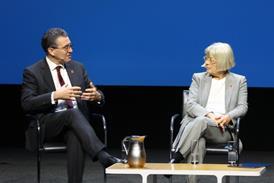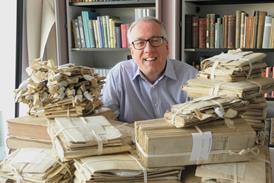She was a lawyer and they dismembered her alive. When the Colombian police found her body, they mistook it for a dog that had been repeatedly run over. It was her 12-year-old son who was called upon to identify her.
Witnesses at the trial of the only man ever charged with the 2003 murder spoke of how he would drunkenly boast of the number of people he had killed. He would say: ‘But the only thing that keeps me awake at night is the screams of that f*cking lawyer.’
That ‘f*cking lawyer’ died because she was doing her job, acting for clients whose land had been unlawfully seized. It was enough to make her a target of the paramilitaries, the paid assassins of the wealthy and corrupt.
The one positive to emerge from her murder was the founding of the Colombia Caravana charity, an international group of lawyers who support human rights lawyers and activists in the South American republic. The Colombian lawyers, members of the Colombian Association of Human Rights Lawyers (ACADEHUM), who pushed for the formation of the charity, envisaged that it would help stop such murders happening again.
Sadly, the killings continue. According to Bogota human rights lawyer Alirio Uribe Munoz, a member of the Jose Alvear collective, some 51 human rights lawyers and defenders were murdered between 7 August 2010 and 31 May 2012. But then, to put that figure in context, some 12,159 homicides took place in the country between January and October 2011. Colombia is a violent country, with guns readily available and a culture of impunity outside the city limits.
The Caravana has now visited Colombia three times – in 2008, 2010 and most recently August-September 2012, when some 45 solicitors, barristers and judges from the UK, the Netherlands, Canada, Ireland, Belgium and elsewhere made up the delegation. Their purpose was to shine a spotlight on how human rights lawyers and defenders in Colombia have their telephones tapped and are murdered, assaulted, unlawfully detained, disappeared and threatened. Colombian lawyers say that the Caravana’s visits, letters of intervention, training and other forms of support have saved lives.
Certainly, the Caravana has added it voice to those urging the government to provide protection for human rights lawyers. The lawyers who hosted the Gazette in the northern city of Bucaramanga, for example, now have two full-time government-supplied minders and three bulletproof vests. Other lawyers, whose needs have been judged to be less pressing, have received just a mobile telephone.
None of these measures protected woman lawyer Yira Bolanas, who was defended by Bogota human rights lawyers. She fared better than her dismembered colleague in that she is still alive, but has endured three terms in prison for ‘rebellion’, which in her case was acting for political prisoners and displaced people. On 26 August 2012, she said: ‘I won’t go into detail about the hell of Colombian prisons, but the people in this room [the Caravana] could be the salvation of political prisoners in this country.’
Bolanas has lost her home, received death threats and spent two years seeking refuge in neighbouring Venezuela. Negotiations are now advanced with a European country to allow her safe haven there.
Other lawyers have also become victims simply because they acted for victims. Time and again they speak of how they were targeted by the paramilitaries, with the connivance of the police, army and civil authorities, because in the course of their work they were likely to expose the crimes of powerful, ruthless people who wanted them silenced.
Bucaramanga human rights lawyers fell foul of the paramilitaries when they acted for Omairi Maldonado Diaz, the widow of a journalist who had been exposing corruption in high places. The paramilitaries who first tried to kill him bungled the assassination attempt and killed his daughter instead. That was 22 April 2004, the daughter’s 20th birthday.
Next they went to his house to kill him, but he wasn’t there. Tragically, the two sons were at home and the paramilitaries killed them instead. The husband died of natural causes a year later and his widow is now in exile in Venezuela, although she returned to Colombia to talk to the Caravana. She said: ‘But I am afraid to be here. The paramilitaries are free on the streets and they know what I look like. I am afraid.'
The Bucaramanga lawyers also act for the families of ‘falsos positivos’ or ‘false positives’. These are people who are falsely identified as left-wing guerrillas or drug runners and are killed so that their murderers - usually soldiers - can claim the bounty that the government pays for every dead body.
Examples abound. The sister of the late Benicio Munoz gave an interview to the Gazette on Monday 27 August in the city of Bucaramanga. Her name is Hilda and she described how her brother disappeared from his farm to re-emerge as a ‘fallen in action’ guerrilla on 28 March 2006. She said: ‘The army refused to release his body unless it was buried immediately because it showed obvious signs of torture.’
Benicio’s family have had their case taken up by Bucaramanga human rights lawyer Leonardo Jimenez, but have been obstructed at every step. The father and brother Edgar were both imprisoned on the grounds of ‘rebellion’ against the state, while the prosecutor’s office and the police have both dragged – and continue to drag - their heels. Another brother, Nilson, was ‘disappeared’ for some hours, but was lucky enough to be located and released. In the meantime, the army has purloined all 72 of the farm’s cattle and destroyed or burnt crops and buildings. The family have been repeatedly threatened – with guns and, once, a hand grenade - in an attempt to make them drop the charges.
Hilda said: ‘We just want justice, but I am scared that Benicio’s children will be the next victims.’ Hilda’s lawyer, Jimenez, said: ‘There has been no attempt at protection from the state or any sign of an investigation. We are preparing a petition to put before the Inter-American Court of Human Rights.’
Another lawyer told the Gazette about the recent case of three drug addicts abducted from the streets of Bogota, only to re-emerge as guerrillas shot in combat. Nobody would miss druggies, their abductors reasoned. Except the mother of one of them did want to know what had happened to her son and an investigation has begun.
Still another lawyer talked about 14 men ‘recruited’ to work on farms in northern Colombia. They were taken up country, dressed in guerrilla uniforms and shot. At 1m Colombian pesos or around £345 per dead guerrilla, that’s almost £5,000 for 14 dead men. But then life is cheap in Colombia and around half of the country’s 45 million population is said to live in poverty.
Not so the foreign companies that are reaping rich rewards from Colombia’s natural resources – its gold, oil, coal, emeralds and fertile land. According to Diego Martinez of the National Movement for Victims of State Crimes (MOVICE), the around 4,500 foreign companies active in Colombia saw profits leap 40% in 2011 to $10,222m (£6,411m).
Some of this money will have found its way into the pockets of the country’s affluent class of corrupt politicians, big landowners, drug traffickers and wheeler-dealers. It will even have filtered down to their private armies, the paramilitaries. But the displaced people you see sifting through rubbish bins on the city streets, the beggars with their missing limbs, will have seen none of it. The country’s infrastructure will not have profited, either: the pavements remain pockmarked with missing manhole covers; municipal water features are full of junk, their fountains dry; and the roads are potholed, the drains blocked, the street lighting intermittent.
How did things come to such a pass? The country has effectively been at war for 50 years. Peasant farmers who worked, but never owned, the small plots of land lent to them by their wealthy employers made ready recruits for the various left-wing guerrilla groups, such as the Revolutionary Armed Forces of Colombia (FARC). The guerrillas promised them, once they had succeeded in overthrowing the regime and formed their own Marxist government, social justice and a fair reward for their labour.
The wealthy ranchers were not willing to sit back and see their affluence eroded, and so raised their own private armies of paramilitaries to counter the guerrilla threat. The consequence was a bloody struggle between the army and paramilitaries on the one side, the FARC and other left-wing guerrillas on the other side, and the hapless small farmers, indigenous groups and Afro-Colombian communities in the middle.
Colombia is the world’s biggest producer of cocaine and drug running was soon thrown into this volatile mix. At first the FARC had disapproved of the trade, but bowed to the inevitable and began taxing growers and traffickers. The paramilitaries, and in particular those who refused to disarm when offered an amnesty beginning in 2003, were quick to become involved in the lucrative trade.
The result is an estimated three million displaced civilians and tens of thousands killed during the conflict. Tourists largely avoid the country, despite its spectacular scenery and rich fauna and flora. And big business has been given a free hand to exploit its workforce and pollute the environment.
An alleged example of the latter can be found in the department of Guajira, where one of the world’s largest opencast coalmines is sited. The mine has been operational for around 20 years and has led to the eviction of an Afro-Colombian community and an indigenous community, called the Wuayuu, both of which had the misfortune to be living nearby.
The mine has already polluted the environment by contaminating the water supply and poisoning air quality, but the company has now decided to divert 26 kilometres of a river, the Rio Rancherias, to provide water for its workings. Local farming communities have for generations relied upon this river for drinking, washing, irrigating crops and watering livestock. The river is soon to run dry unless the community’s lawyers, the Jose Alvear Restrepo Collective (CCAJAR), manage to stop owners which they allege are accustomed to riding roughshod - and with impunity - over the rights of others.
The Cerrejón coal mine is independently operated, but belongs in three equal parts to subsidiaries of BHP Billiton, Anglo-American and Xstrata. The Gazette contacted the London press offices of all three companies and was referred to spokespersons in Colombia and Australia. In a statement received today, a spokesperson for the Cerrejón mine, Carlos Franco, said: ‘Cerrejón appreciates the opportunity to clarify this information.’ His full response is appended to the end of this piece.
Overall, though, it’s a grim picture in Colombia - but is there anything good to say about this vast country, with its spectacular Andes scenery, its mineral wealth, its rivers and lakes containing more fresh water than the US and Canada combined?
Perhaps the best that can be said is last week’s news - which broke, by coincidence, when the Caravana was in Colombia - that the FARC and the government, led by president Juan Manuel Santos, has agreed a ‘route map’ to peace.
There is cause for moderate optimism that the peace talks, this time, will succeed. The FARC’s longtime ally, Venezuela’s president Hugo Chavez, has thrown his weight behind the talks and so has Cuba, which is seeking rapprochement with the US. The FARC itself is believed to have lost its appetite for the struggle, as Colombia’s 380,000-strong army, backed with billions of dollars of US military aid, has weakened the rebels’ morale, disrupted their communications and killed senior commanders.
The people of Colombia deserve some peace. Despite the awfulness of the last half a century, they come across as irrepressibly cheerful, smiling and helpful, and patient with lost gringos.
They are proud of their country and the face it presents to the world - although one anecdote heard in Bogota last week is perhaps apocryphal. A Mexican woman takes a taxi late at night. Two minutes into the journey, the driver stops the cab, draws a knife and says they are going to visit the city’s cashpoints until her bank account is emptied. He frowns when she protests, saying: ‘You’ve got a funny accent. What part of the country do you come from?’
She replies that she doesn’t come from Colombia, but is Mexican. ‘I don’t want you going home to Mexico thinking badly about Colombians,’ says the taxi driver. ‘So… So I’ll only take you to one cashpoint.’
Should you take the family on holiday to Colombia? No, not yet – but maybe soon.
Jonathan Rayner is a reporter on the Gazette
Carlos Franco's full response
‘A project to consider the possible modification of a section of the Rancheria river has been contemplated since the beginning of the Cerrejón mining operation, but only since 2004 have in-depth studies been developed to determine the technical, economic and environmental viability. It is important to note that to date, no application has been made to ANLA (the Colombian Environmental Licensing Authority) to amend Cerrejón’s environmental management plan or its licence so as to advance this project.
‘Within the current design of the new channel, several alternatives have been considered, following the highest international engineering standards to minimise the adverse effects on the dynamic, physicochemical and hydrobiological quality characteristics of the water itself.
‘To mitigate and compensate for the potential impact of reduced river flows during dry seasons, we propose the construction of a reservoir with a capacity to store 12 million cubic meters of water, with the objective to ensure the flow of water throughout the year (which is currently not the case in the dry season) to communities living downstream of our operation.
‘The project of course has developed a preliminary environmental impact study that has taken into account an review of the environmental baseline indicators and the identification and evaluation of the most relevant environmental impacts. Based on these evaluations, we have identified the measures to manage, prevent, mitigate and compensate said impacts. These findings have been shared with national and international stakeholders.
‘Our environmental and community policies require that we must develop our operation in harmony with the environment and society; contributing to development, wellbeing and the cultural heritage of the communities in our area of influence.
‘Element 7 (Environment) of our Operational Integrity System establishes, among others, the following requirements:
- We identify and evaluate all environmental aspects and impacts associated with Cerrejón operations and establish corresponding measures for prevention, mitigation and compensation, according to the level of impact.
- We establish and implement plans and programmes for the sound management of water (including waste water control), control of air emissions (dust and gases), rational use of energy, preservation of soil, vegetation cover, wildlife and handling and final disposal of waste matter (both organic and hazardous), according to the requirements.
- There are programs in place to ensure that ordinary solid waste and hazardous waste are eliminated, reduced, reused, recycled, treated or disposed of accordingly. We regularly assesses the potential impact through our Safety Health Environment and Communities committee (SHEC) of all waste generated, especially hazardous ones.
‘The results of all these programmes are publicly reported and some of them are developed jointly with communities or NGOs.’

















![Emily-1[17]](https://d1d8vslyhr7rdg.cloudfront.net/Pictures/274x183/3/1/7/120317_emily117_695594_crop.jpg)







No comments yet